Vol. 5 No. 33 TROPIC LIGHTNING NEWS August 31, 1970
Index
Unit Overcomes Supply Problems
Bobcats Chase, Finally Catch NVA Battalion
By 1LT MARTIN E. WEBB
FSB SWARTZ - Given a grenade shot off your web gear, the cord of a headset
severed by an AK round and an M-16 with a .51 caliber round lodged in the
barrel, you've got supply problems.
And these were the problems which faced Alfa Company, 1st Battalion (Mech)
5th Infantry, during recent enemy contact east of Xuan Loc.
On Their Heels
According to Staff Sergeant Norman Ficke, of Birmingham, Mich., the third
platoon sergeant, "We had been on the heels of an NVA battalion for the past
week and today we found them."
Pulling up rocket propelled grenade screen as the smoke of burning trash
fires drifted through the air, the Bobcats prepared to move out on an all day
reconnaissance in force (RIF) from their night laager position.
The Bobcats threaded their way through dense jungle into a large open field
only to plow back into the heavy vegetation. Restricted by falling dead trees
and a large stream, the company dismounted to RIF further into the heavy growth.
All Hell Breaks Loose
"We sensed that something was in there," said Rifleman Private First Class
Patrick Harding, of Portland, Ore. "When we moved in closer to take a look, all
hell broke loose. They really had us pinned down for awhile."
After putting down a heavy cover of fire, the Bobcats rejoined the rest of
the men on their tracks to make use of their .50 caliber machineguns. Artillery
was then called in to pound the enemy positions.
"We were pretty lucky," said 2nd Lieutenant Richard Kvies, of Brooklyn, N.Y.,
whose first platoon was the point element. "Some were as close to us as 15
yards. They shot my RTO's (radio-telephone operator) hand-set cord in two."
Half A Grenade
The company commander, Captain Jack Dempsey, of Twin Falls, Ida., agreed to
that as he held a grenade which had been shot in half from his web gear.
"I've never had it that close before," Dempsey said.
"Another GI held up his M-16 for inspection after the contact. A .51 caliber
round had shattered his hand guards and lodged itself in the barrel bending it
into a right hand turn signal. The Bobcats sustained three slightly wounded.
"The supply sergeant will really raise hell with us," grinned the mortar
platoon sergeant, Sergeant First Class Elwood Dixon, of Fallentimber, Pa.
| CLOSE CALL -- Captain Jack Dempsey, 1/5, holds up split grenade for examination. (Photo by 1LT Martin Webb) |
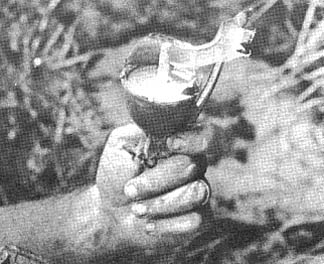 |
Enemy Talks Too Much
GI Gives Business to VC
By SP4 RICH ERICKSON
DAU TIENG - During a recent bushmaster near here, the men of 25th Division's
Alfa Company, 2nd Battalion, 14th Infantry, killed six enemy and uncovered a
Communist bunker complex.
On the first day of the operation, two North Vietnamese soldiers moving in
semi-darkness down a thickly vegetated trail spotted a partially concealed GI in
the heavy brush.
Casually, they asked, "Are you NVA or VC?"
They were answered by a direct statement from the business end of an M-60
machine gun. The result: two less NVA.
Surprised
"They had their AK-47s on their shoulders when they spotted me," said the
machine gunner, Private First Class Rich Lane, of Tecumseh, Neb. "I heard them
say something in Vietnamese and I was quite surprised later when our Kit Carson
gave me the translation. I guess they never suspected GIs to be in the area."
The second day of the bushmaster proved to be almost as eventful.
Private First Class Earl Ford, of Susanville, Calif., was providing cover for
the machine gunner who was setting up claymores when he spotted movement to his
front.
Quick Burst
After a quick burst of small arms fire, the squad moved out to recon the
area. They found two dead Viet Cong, who had been pulling water resupply from a
bomb crater.
Moving out from their AP (ambush patrol) site, the company located an enemy
bunker complex, with 12 bunkers still in the process of being constructed. It
was searched thoroughly and then destroyed.
Other action during the bushmaster resulted in two more enemy dead, bringing
the total to six for the four day operation.
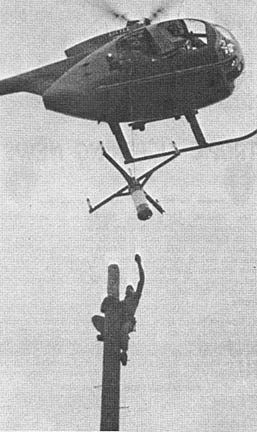 |
ALL IN A DAY'S WORK -- A light observation helicopter (LOH) dangles in the sky, helping a trooper with a long arm put a few finishing touches on a new signal tower. The action took place recently at 3rd Brigade headquarters 25th Infantry Division base camp, Cu Chi. (Photo by SP5 Doug Sainsbury) |
Dragons Spring Trap;
Blast Stunned Enemy
By SP4 RICH ERICKSON
FSB BYRD -- The soldier's mechanical partner, a claymore mine, led the Golden
Dragons of the 25th Division's 2nd Battalion, 14th Infantry, to a brief clash
with the enemy in which five Communists were killed near this fire base.
The men of Delta Company, 2nd of the 14th, upon hearing the muffled explosion
of one of the mechanical ambush devices set up near Byrd, quickly saddled up to
investigate. Meanwhile, the mortar platoon prepped the ambush site.
Reconning the area in force, the GIs discovered the effect their silent but
deadly partner had on the enemy. One NVA lay dead from the initial blast and
four more were standing in the area in various states of disbelief.
After a brief fire fight, the remaining four enemy soldiers were killed.
Searching the enemy, the dragons found three AK-47s, one K-54 pistol,
binoculars, a compass, five maps and about three pounds of assorted documents.
"All five had NVA silver star belt buckles," one member of the company
stated. "Combining this with other indications, we believe one of them was an
officer of some importance traveling with heavily armed security."
In related action, a Dragon unit was making an early evening sweep a few
miles east of the Boi Loi Woods when they spotted an undetermined number of
enemy and engaged them with small arms fire.
No enemy casualties were found during a subsequent search of the area.
However, 600 rounds of M-60 and 150 rounds of .50 caliber ammunition were
uncovered. A pair of trousers, one shirt and one NVA canteen were also found.
The next day, Bravo Company, 2nd of the 14th spotted three to five NVA. A
hasty ambush was set up in the lightly wooded area, thick with heavy
undergrowth.
The Dragons opened up on the enemy with small arms fire and claymores.
Returning with small arms fire, the enemy withdrew leaving behind one dead.
Page 2 TROPIC LIGHTNING NEWS August 31, 1970
Decorated
| SILVER STAR | |
|
CPT George J. Compton, A Btry, 2d Bn, 77th Fld Arty CPT William M. Haskett, Co C, 2d Bn, 22d Inf CPT Less P. Wright, Co D, 3d Bn, 22d Inf |
1LT Thomas G. Harris, Co D, 3d Bn, 22d Inf 1LT Melvin A. Miller, Co E, 2d Bn, 12th Inf SSG Charles J. Jones, HHC, 2d Bn, 22d Inf |
|
SOLDIER'S MEDAL |
|
| SP5 Jack A. Wilson, Co A, 25th Avn Bn | |
|
BRONZE STAR |
|
|
1LT Lonnie D. Hines, B Btry, 2d Bn, 77th Fld Arty 1LT James J. Nemec, Co E, 4th Bn, 9th Inf 1LT Juan E. Rivera, B Trp, 3d Sqdn, 4th Cav 1SG Jesse W. Frier, HHC, 4th Bn, 9th Inf SGM Luther J. Shepherd, HHC, 4th Bn, 9th Inf SSG Steve H. Arch, B Btry, 7th Bn, 11th Fld Arty SSG Howard H. Dean, Co A, 4th Bn, 9th Inf SSG Allen H. Erickson, Co D, 65th Engr Bn SSG Robert Gorham, 66th Cbt Trks SSG Dennis H. Wallman, B Btry, 7th Bn, 11th Fld Arty SGT Joseph R. Cunningham, Co C, 2d Bn, 27th Inf SGT Howard W. Moore, 25th MP Co SGT Lyle E. Silverthorn, Co C, 1st Bn, 27th Inf SP5 Ronald A. Haver, Co D, 65th Engr Bn SP5 Robert Rodriguez, Co D, 65th Engr Bn |
SP4 Matos G. Alvarado; Co C, 2d Bn, 22d Inf SP4 Robert J. Butzler, Co C, 2d Bn, 14th Inf SP4 Dennis E. Moran, Co C, 1st Bn, 27th Inf SP4 Gerald Molton, Co A, 4th Bn, 9th Inf SP4 Steven A. Ott, Co A, 4th Bn, 9th Inf SP4 Richard P. Ramirez, Co C, 1st Bn, 27th Inf SP4 Stanley L. Schafer, Co C, 2d Bn, 14th Inf SP4 Lawrence Tanner, Co D, 65th Engr Bn PFC Robert J. Becker, Co C, I st Bn, 27th Inf PFC Paul L. Cassidy, Co C, 1st Bn, 27th Inf PFC Raymond Cieslica, Co C, 2d Bn, 22d Inf PFC Byron J. Johnson, Co D, 1st Bn, 27th Inf PFC Harris E. McGill, Co D, 1st Bn, 27th Inf PFC Jack Sutherland, Co C, 2d Bn, 14th Inf PFC Robert L. Williams, Co D, 1st Bn, 27th Inf |
Education Center
New Courses Are Slated
BY PFC PATRICK F. MURPHY
Cu Chi - The 25th Infantry Division Education Center, which offers
a continuing series of college and high school subjects, recently announced the
courses scheduled for the fall program.
"We've got three new electives from the University of Maryland,"
said William Britman, of Indianapolis, the center's director.
Business Law, Introduction to mathematics, and introduction to
sociology are the courses being made available by the university's overseas
extension program. While the cost of each course is $60, the GI-student
pays only $15 of this with the government picking up the rest.
"This doesn't affect your benefits from the GI bill at all," said
staff member Specialist 4 Robert Marasa. The only other cost for these
three classes is the price of text books.
Marasa also noted that "the ed center is making available a new
course entitled History of the American Negro." The course is designed to
closely parallel the history of the Afro-American most commonly offered in
civilian colleges and universities.
Emphasis is on African background; slavery and the slave trade;
reconstruction; the Negro in the North and South and the Twentieth Century
struggle for equality.
On September 4, the ed center will introduce a number of United
States Armed Forces Institute (USAFI) subjects. Included are seminars
entitled: History of Western Civilization; American Government; Criminology;
Principals of Accounting; Real Estate Principals; French I; German I and
Introduction to Data Processing.
Classes are held two nights per week from 6:30 to 9:30
"There's no charge for any of these subjects," Marasa said.
|
CHANGE OF COMMAND Returning to Vietnam for his second tour, Colonel John P. Cooper, became commanding officer of the 25th Infantry Division Artillery (DIVARTY) during a recent ceremony. The 19 year veteran from Shawnee, Okla., succeeded H.A. Buzzett, of Apalachicola, Fla., who has returned to CONUS to become HAWK Project Manager at Redstone Arsenal, Ala. On his first tour, Colonel Cooper was commanding officer of 1st Battalion, 8th field Artillery. Prior to assuming command of DIVARTY, Colonel Cooper was chief of staff, management division at the pentagon. A distinguished military graduate, Colonel Copper also has a B.A. in geology and an M.B.A. in management, both from the University of Oklahoma. |
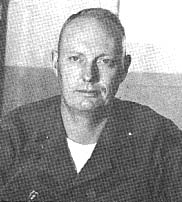 |
Booby Trap School Aids Operations
By PFC DAN LOWRY
CU CHI - Because the majority of casualties inflicted on men of the
25th Infantry Division are from mines and booby traps, a special step has been
taken by members of the Tropic Lightning Academy.
Recently, men of the 2nd Battalion, 27th Infantry began taking
classes in demolition at the Mine and Booby Trap School.
In the short time since the beginning of classes, operations
conducted 10 miles north of here by the 2nd Wolfhounds have proved fruitful in
finding and destroying booby traps before they are detonated.
"Operating in open places makes you vulnerable to traps," explained
1st Lieutenant James Lawrence, a Bravo Company platoon leader. The VC and
NVA study movements of American units and determine where they can inflict the
most casualties. GIs should learn more about demolitions because, in many
instances. placing a charge and blowing a trap involves some real know how.
Many men in the latter part of their tours here think there is
nothing else to learn.
"Such an attitude could prove to be very unhealthy," said Sergeant
Stephen Moore, of Tacoma, Wash. "Take the classes seriously and they're a
blast."
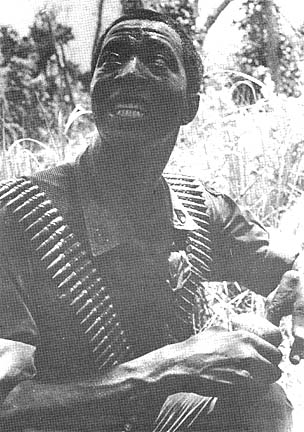 |
DOING HIS JOB -- SSG Paul Love, of Dallas, prepares C-4 explosive to destroy two claymores found while on operation in the Boi Loi Woods recently. Love is a member of the 3rd Squadron, 4th Cavalry. (Photo by SP4 Howard Lavick) |
Tropic Lightning Tots
The Commanding General Welcomes
The Following Tropic Lightning Tots
To The 25th Infantry Division – As
Reported By The American Red Cross.
Born To:
| August 6 SGT Henry J. Smith, Co A 2nd Bn 22nd Inf, girl SP4 Richard Krajewski, 25th Admin Co, boy August 8 SP4 Tom Ketterman, 86th Sig Bn, boy |
August 9 PFC Gary A. Mullins, HHC 2nd Bn 27th Inf, girl SP4 James A. Wells, 94th Maint Co, girl August 12 SP4 Dan Flora, 25th Admin Co, girl |
The TROPIC LIGHTNING NEWS is an authorized publication of the 25th Infantry Division. It is published weekly for all division units in the Republic of Vietnam by the Information Office, 25th Infantry Division, APO San Francisco 96225. Army News Features, Army Photo Features, Armed Forces Press Service and Armed Forces News Bureau material are used. Views and opinions expressed are not necessarily those of the Department of the Army. Printed in Tokyo, Japan, by Pacific Stars and Stripes.
MG Edward Bautz, Jr . . . . . . Commanding General
MAJ Robert E. Kelso. . . . . . Information Officer
1LT John Caspari . . . . . . . . . Officer-in-Charge
SP4 William M. Lane . . . . . . Editor
SP4 Scott Watson . . . . . . . . Assistant Editor
SP4 Joseph V. Kocian . . . . . Production Supervisor
BATTALION CORRESPONDENTS
| SGT Mike Keyster SP4 Tom Benn SP4 Frank Salerno PFC Dan Lowry SP4 Greg Duncan SP4 Rich Erickson SP4 Ed Toulouse SGT Mark Rockney SGT Mike Conroy SP4 William Zarrett SGT Daniel House PFC Irwin Polls |
4/23 7/11 2/22 2/27 2/27 2/14 2/12 2/12 3/4 Cav 4/9 4/9 269th |
SP5 Tom Watson SP4 William McGown PFC James Stoup SGT Derr Steadman SP5 Doug Sainsbury SP4 James Duran SGT Jack Strickland SP4 Dan Davis SP4 Kris Peterson SP4 Frank Morris SGT Bob Lodi SGT Byron Fites |
725th Divarty 65th Eng Discom 2/77 3/13 1/27 1/27 3/22 2/34 1/5 4/23 |
Page 3 TROPIC LIGHTNING NEWS August 31, 1970
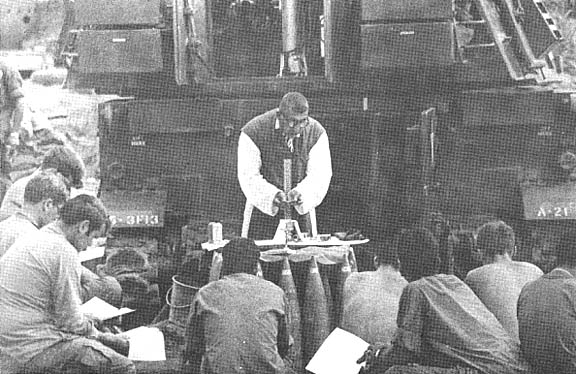 |
| ON SUNDAY, CHURCH COMES TO THEM - To the men of Alfa Battery, 3rd Battalion 13th Field Artillery, it is Sunday simply because it is the day chaplains come to them. Father Anthony V. Rodriques says Mass for a group of Clansmen. (Photo by SP4 James Duran) |
Mech Unit Goes Leg
Bobcats Take to Foothills
By SP4 RICH FITZPATRICK
XUAN LOC - The first thing the men of the 1st Battalion (Mech), 5th Infantry
noticed about their new area of operations near Xuan Loc was the rolling hills.
This was a great change from the miles of flat land that dominated their
previous AOs in the Tay Ninh-Cu Chi areas.
After a month of day and night reconnaissance in force missions through the
area, it was decided that it was time to check out the hilltops for signs of
enemy activity. The problem was that the Bobcat tracks could not operate
effectively in that terrain.
Going Leg
The only answer was for the mech unit to leave their armored personnel
carriers and go straight leg.
Few of the men of Alfa Company, 1st of the 5th, had ever been on an Eagle
Flight. "The only helicopter I've been on is a dustoff," Private First Class
Mark Kelly, of Battle Creek, Mich., remarked.
The object of the mission was to check out the summit of Hill 322 and its
surrounding foothills. The men were awakened at 6 a.m. to prepare for the day's
mission.
LZ Prepped
Immediately prior to the air insertion, the landing zone was prepped with
8-inch, 155 mm, 105 mm artillery and 4.2 mortars. As the first lift touched
down, two gunships provided additional support.
The LZ was calm for both lifts so the Bobcats regrouped and headed for Hill
322. As they started up the hill, the terrain changed. The thick foliage
reminded them of their former AO in the triple-canopy jungle of War Zone C.
Often on hands and knees, the men made their way up the hill.
As the Bobcats moved up the steep, rocky cliffs, Private First Class Paul de
Ghetto, of Clifton, N.J., a company RTO (radio telephone operator), said: "This
is like OJT for being a mountain goat."
No Trace
In early afternoon, the men reached their objective, the summit of Hill 322,
but they found no trace of the enemy.
"From now on it's downhill all the way," said one tired trooper. However,
going down was not quite as simple as it seemed. The previous evening's rain
made the slope as slippery as Aspen in February.
After a couple of hours of sliding, the men arrived in an open field where
they were picked up by APCs of Charlie Company, 1st of the 5th.
That evening, back at their laager site, Staff Sergeant John Sharken, of
Mexico City, reflected: "Well, it's not as bad as I thought it would be. Being
straight leg is OK, but I'd rather spend the day riding than walking."
It's Happening
THE 65th ENGINEER BATTALION HAS 10,000 BARS ... Of soap. Thanks to the efforts
of 1st Lieutenant Stephen K. Rhyne, from Stanley, N.C., who heads the
battalion's MEDCAP team. The team has been suffering from a lack of soap and
dental supplies. So, after considering a number of ways to remedy the
situation, Rhyne wrote to his parents asking them to arouse public interest in
the MEDCAP program in Stanley (pop. 2,500). A few weeks later, the
contributions started pouring in from churches, church sponsored groups and even
his mother's bridge club. Slam. To date, Rhyne has received not only the
10,000 bars of soap, but also hundreds of toothbrushes and tubes of toothpaste.
Thank you, Stanley, from Lieutenant Rhyne and the people of Vietnam. No thanks
from the 25th Division's APO, just a little disturbed at their extra burden.
LONG DISTANCE PADRE ... If you get up with the sun in the morning, you just
might see a slender, silver-crowned figure jogging through the streets of Cu Chi
base camp. Some young toe head, you might think, too soon out of college to
know any better. Or, an American athlete, perhaps, here in Vietnam on a
goodwill tour, trying to stay in shape. Wrong. And wrong again. The pursuer
of physical fitness has been out of college for more than 20 years. He is a
lieutenant colonel, a veteran of 35 bombing missions over Germany during World
War II and a priest. Father Joseph Patrick Mulhern runs five miles every
morning. He does 50 push-ups, 50 sit-ups and 50 deep-knee bends "to keep from
gaining weight."
Father Mulhern was in pre-med at Providence College when he decided to enlist
in the Army Air Corps in 1943. He spent most of his time in the air at the
controls of a B24 Liberator. When the war ended, Mulhern thought "We had won
the war and lost the peace" so planned a future in the diplomatic corps. He
enrolled in the Georgetown University School of Foreign Service. When he was
about to embark on his diplomatic career, Father Mulhern had a change of mind.
"I decided the problem was theological," he said. After seven years of
preparation, he was ordained in 1954.
The priest, who returned to active duty in the Army in 1960, is serving his
second tour in Vietnam and his second in the Cu Chi area. "The big surprise
this time,' he said, "was that we were able to drive up to Cu Chi. You couldn't
the last time I was here (1964-65). Nothing was moving in those days."
As a 25th Infantry Division Chaplain, Father Mulhern is a busy man. If you
want to talk to him -- especially early in the morning -- you'll have to catch
him.
CAN YOU DRAW? ... If you are a cartoonist of some skill, and are itching for an
outlet for your work, we've got a deal for you. The beloved "Tropic Lightning
News" will publish your cartoons regularly if you submit them regularly. We
won't make you rich, but your fame will no doubt spread far and wide. If
interested, call the Division Information Office (extension 5011) or drop by and
see us.
DIVISION DOUBLE - TALK ... The 25th Division publishes a two-page list of
preparations unit soldiers should make before going on R&R. But, item 2,
paragraph e confuses us a bit. "(Bring) a minimum of 5 copies of your orders,"
the paragraph says. "All personnel will receive their orders at the briefing at
the Ilikai East Service Club the day indicated on the special instructions on
their orders." What? How does a soldier know what day to go to Ilikai East to
pick up his orders if he doesn't have any orders in the first place?
Ladies Boost Morale At Hawk Base Camp
By SGT MIKE KEYSTER
FSB TOMAHAWK -- 25th Division Tomahawks of the 4th Battalion (Mech), 23rd
Infantry have recently discovered that a woman's touch around the laager site
can be a real morale booster.
This is especially true if there are six women and they are pulling KP.
The Vietnamese ladies travel 40 miles each day to their jobs at the laager
site. They arrive from Xuan Loc on a resupply truck in the early morning and
return to their homes in the evening.
According to Specialist 5 Elmer H. Di Pietre, of Besgrave, Me., mess sergeant
for Headquarters Company, the Vietnamese women have definitely boosted morale of
the troops since assuming their duties of cleaning pots and pans, serving food
and policing in and around.
"It seems to give everybody a little lift," he said.
While most GIs hate being put on KP, the Vietnamese women don't mind at all.
"They're really very good workers," said Specialist 5 Calvin Perry, of
Columbus, Ga., first cook for Headquarters Company.
Perry said that the extra workers were handy since "we're really short on
cooks now."
"And if we didn't have these Vietnamese KP's, my cooks couldn't even take a
break," added Di Pietre.
Di Pietre also noted that the personal appearance of Tomahawk GIs has improved
since the arrival of the ladies. "Almost everyone used to come to chow with
muddy boots and fatigues, but now most have clean clothes, fresh shaves and
haircuts.
| GET OFF MY BACK! - Specialist 4 Henry J. Flores, of Venice, Calif., and a member of A Battery, 5th Battalion, 42nd Field Artillery, looks askance at Jo Jo, gleeping gleefully at his head. (Photo by 1 LT Martin Webb) |
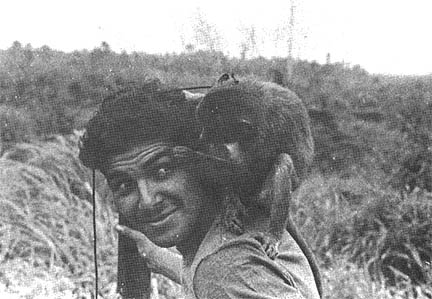 |
Page 4-5 TROPIC LIGHTNING NEWS August 31, 1970
Triple Deuce Returns to Cu Chi
Story and Photos By SP4 FRANK H. SALERNO
CU CHI - After spending more than three months on operations in and around
Cambodia and War Zone C, the 25th Division's 2nd Battalion (Mech), 22nd
Infantry, recently returned here for a maintenance standdown.
Upon arriving, the Triple Deuce Regulars were welcomed by the division's band
and the Red Cross Donut Dollies.
"It was nice to see the girls and band out there despite the day's rain and
mud," said Specialist 4 Jerry Smith, of Bravo Company, from Edision, N.J.
During the day, the men made necessary repairs on their armored personnel
carriers.
"It sure is great to be back here in Cu Chi for a couple of days," said
Specialist 4 Theodore White from Princeton, W.VA. "After being out in the
boonies for so long, you really appreciate the base camp."
After a hard day's work, the men were able to enjoy plenty of cold drinks and
snacks at the Enlisted Men's Club.
Within a few days, the maintenance work was completed and the battalion was
ready for its next assignment.
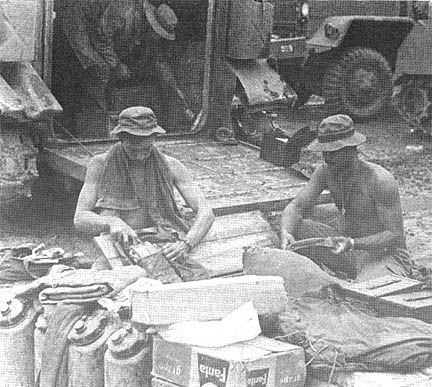 |
SPIT AND POLISH -- Men of Alfa Company, 2nd of the 22nd sort through their gear and clean up their APC while in Cu Chi on a maintenance standdown. |
| NEITHER RAIN -- The Donut Dollies were there to greet the Triple Deucemen despite the rain. They were rewarded by constant attention. |
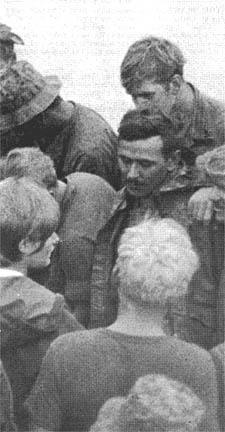 |
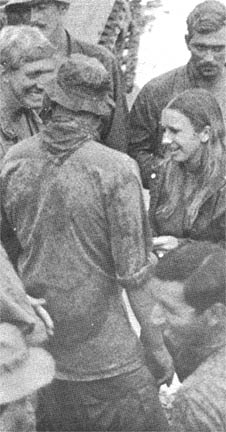 |
NOR SLEET -- A Dollie's smile eases the pain of a long journey for men of the 2nd of the 22nd. |
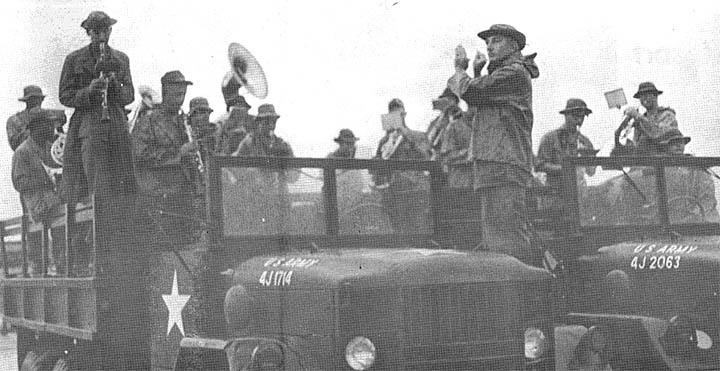 |
| OVERTURE -- Braving the elements to greet the mech unit, the 25th Division Band makes music. The 2nd of the 22nd returned to Cu Chi for the first time in three months of action in and near Cambodia. |
| PARKING LOT -- When the 2nd of the 22nd wheeled and tracked into Cu Chi, the air was heavy with rain. Here, Triple Deuce APCs are secured for the night. |
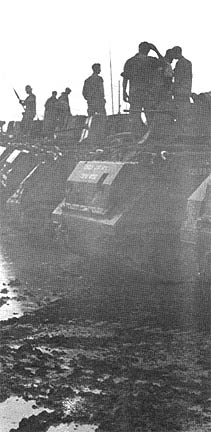 |
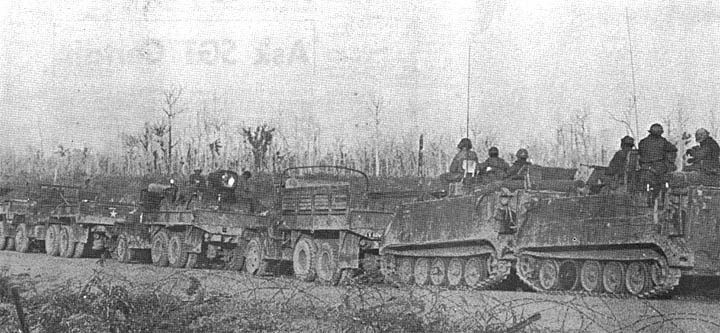 |
| CU CHI BOUND -- Elements of the 2nd Battalion (Mech), 22nd Infantry form a convoy and begin their long journey from Katum to Cu Chi after completing operations there. Armored personnel carriers are scattered throughout the convoy to provide security for the wheeled vehicles. |
Page 6 TROPIC LIGHTNING NEWS August 31, 1970
Nui Ba Den - Circa 1990
The Black Virgin Resort
By SP4 RICH WERNER
NUI BA DEN -- As the red and yellow striped Swiss-made cable car gracefully
shimmies down its steel lifeline on the once scarred northeast slope of the
mountain, a flock of carefree vacationers anxiously awaits their transportation
to the luxurious resort at the peak.
Loaded with assorted sports paraphernalia from bikinis to snow skis, they push
and shove, as all tourists do, failing miserably to achieve any order out of the
helter-skelter.
Excitement rises as the car gently inches into its dock and comes to a stop.
Over the loud speaker, the cackle-voiced station master contributes his own
feeble static to the deafening noise of the almost hysterical mob.
"All aboard for the Black Virgin Hotel and Health Spa. We at Black Virgin
hope you have a pleasant stay. If there is anything..."
Completely ignoring the weak voice over the squawk box, the surging crowd
flows amoeba fashion toward the ticket gate. An obviously annoyed employee
wearing the famous Black Virgin patch, snatches the tickets as the gaudily
dressed tourists pass one by one through the whirling turnstile.
The cable car operator, an elderly gentleman with a Fu Manchu moustache,
flicks a few switches and the car begins its slow climb to the 3,000 foot
crest. Its cargo of sardine packed passengers presses closer to the all-glass
sides, cameras at the ready for the breathtaking view. The sound of clicking
shutters and the usual "oohs" and "ahs" fill the air-conditioned tram. During
the 15-minute ride, the old man points out the points of interest.
"On the left are the remnants of an old burned out Viet Cong bunker complex,
dating back to 1970. And on your right, a genuine American 500 pound bomb dud
from a B-52 raid, specially preserved for your viewing pleasure." More "oohs"
and "ahs."
Half way up the mountain, the scenery takes on an abrupt change -- from the
traditional lush jungle greenery to the artificial snowy white ski slopes,
covering the peak like an egg shell.
The cable car rumbles to a halt at the top, and the guests are greeted by a
pineapple bearing Black Virgin bunny, internationally selected by none other
than Nguyen Van Nhefner himself.
On their way to the informal briefing room, the guests are led close by the
heated Olympic swimming pool, past the ski lodge and through the
picture-windowed casino, fashioned in early Buddhist decor.
"All the facilities at Black Virgin are at your disposal," says the
attractive hostess. "Please feel free to spend as many piasters as you like."
Thus for two weeks, the happy vacationers can put aside the worries of the
hustle-bustle business world and frolic amidst the mountain paradise resort of
Black Virgin Mountain-1990.
Former Grunt Trims Fellow Infantrymen
By SP4 ED TOULOUSE
DAU TIENG - The men of the 25th Division's 2nd Battalion, 12th Infantry at
Fire Support Base Warrior are getting along very well with some trimming done by
a friend and former fellow infantryman, Sergeant Angel Ortiz, of New York City,
a licensed barber now doing his thing in Vietnam.
The Warrior barber's shop quite assuredly lacks some of the niceties of its
former New York counterpart. In fact, the shop consists of a poncho suspended
on four poles. It doesn't even have the traditional striped pole.
Ortiz, however, seems to have no problems enticing customers -- voluntarily
or involuntarily.
"When a company comes in from the field, I average about 25 customers a day,"
he said. "And many of them are pretty shaggy."
Ortiz's presence seems to bolster the confidence of many Warriors. "Many of
us have been in the field with him and we know we can expect a good haircut,"
one man explained.
As for the cost of an Ortiz haircut, competition doesn't stand a chance -
it's free.
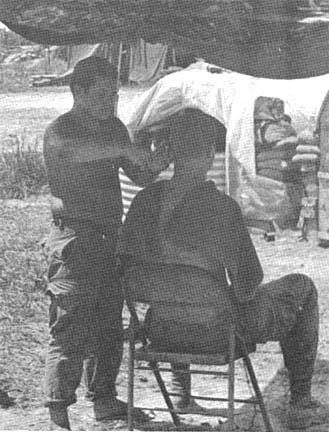 |
SNIP, SNIP - A barber in the middle of a fire support base? That's the question Sergeant Angel Ortiz, of New York City, a licensed barber, quite possibly keeps asking himself. (Photo by SGT Mark Rockney) |
DA Form Brings GI True Love
By SP4 RICH FITZPATRICK
XUAN LOC - Can a man find true love while in the Republic of South Vietnam?
Can a Department of the Army form bring two people separated by an ocean closer
together?
Specialist 4 Michael H. Rose of Delta Company, 1st Battalion (Mech), 5th
Infantry answers with an emphatic "yes" to both of these questions.
"It's all the public information office's fault," Rose said, "When I
received a Bronze Star, there was the PIO with a hometown news release form
(DA-1526). I filled it out, then forgot about it all."
A month later the Palo Alto (California) Times carried a large article about
Rose's Bronze Star. Soon he was receiving letters from old friends and even
from people he had never met. His fourth grade Sunday school teacher remembered
him and sent a "goodie package."
However, the most interesting to Rose was a letter from a girl who was
impressed by the article and wanted to let him know that the people back home do
care.
As the two exchanged many letters, the "caring" became more personal.
Recently, Rose was asked what he thought of the Army hometown news release
program.
He stared at the four pictures of his bikini-clad friend from Palo Alto,
smiled a knowing smile and said: "Dig it, man. It's outa' sight."
Ask Sgt. Certain
DEAR SGT CERTAIN: I think our CO is pulling a fast one. The company took in a
Hoi Chanh last week but the CO won't turn him in. Apparently, the fellow was
head chef at COSVN. His souffles are unbelievably good and he makes a
magnificent casserole bordelaise out of our surplus stock of ham and lima
beans. Can he do this?
No
Gourmet
DEAR NO: He certainly can. The secret is in the bourdelaise sauce and letting
the limas saute to just the right point.
DEAR SGT CERTAIN: I have been told that GIs must get a haircut before going on standdown or R&R. Why?
PFC
Harry Burnside
DEAR HARRY: According to a special directive written by Lt. Gen. Y. Brenner at USARCLIP, long hair makes it hard to have fun since it gets in your eyes and you
can't see what's happening. The general says that fellows on R&R discover that
lovely ladies detest long hair. Not only that, the general says, if you go on
R&R with shaggy locks, you may be mistaken for a civilian and not be accorded
all the special treatment short-shorn soldiers receive.
DEAR SARGE: I have an embarrassing problem. I wet my bed. When I was out in
the field, it wasn't so bad. I usually wake up in a rice paddy and nobody
could tell. But now that I work in the rear, I wake up with a puddle under my
bed. What can I do?
M. Barrassed
DEAR M: Re-up for the field?
Page 7 TROPIC LIGHTNING NEWS August 31, 1970
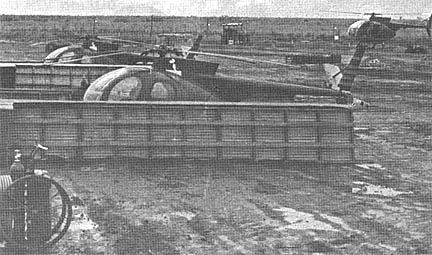 |
THE PAD -- There is always something happening at the 3rd Brigade (Snoopy) Aviation Pad. Here, a Light Observation Helicopter (LOH) hovers prior to take off, while two other LOHs stand ready. |
| ROTOR CHECK -- Specialist 4 Conrad Knight, Milwaukee, checks main rotor assembly of a Light Observation Helicopter while Snoopy checks his footwork. Knight is a crew chief for the 3rd Brigade Aviation. |
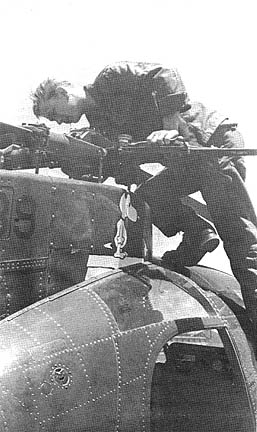 |
Snoopy Gets 'em There
Story and Photos By
SP4 RICH DOMBROWICKI
CU CHI - "We usually work about 18 hours everyday, from 5 a.m. to 11 p.m."
Such is life here for the men of the 25th Division's 3d Brigade (Snoopy)
Aviation, according to Crew Chief, Specialist Four Allen Landon, of Idaho Falls,
Ida.
The Snoopy Pad personnel are constantly on the go. The pilots fly Light
Observation Helicopters (LOH) to all parts of the division's area of
operations. Meanwhile, the crew chiefs keep busy maintaining the fleet of LOHs
in top condition.
"Most of our missions are of a reconnaissance nature," said Warrant Officer
Donnie Braswell, from Rives, Tenn. "We fly unit commanders (usually battalion
commanders) over operations areas so that they can get a good view of the
overall tactical situation."
In addition, the LOHs act as observation aircraft for convoy security and
rome plow operations as well as marking targets for Forward Air Control and
fighter strikes.
"A LOH is ideal as an observation tool," Braswell continued. "You get an
excellent view from all angles because it is such a small craft. And because of
its size, it can maneuver into tight areas where no other chopper can go."
Other advantages of the LOH are that it is highly maneuverable because of its
lighter weight, accelerates quickly, is durable and economical in operation.
"It's also the fastest of any helicopter at low levels, and needs only one
pilot," Braswell added.
Because of these many attributes, LOHs are often called upon to give quick
transportation in top priority situations.
"That's why they must be kept ready," said Specialist 4 Conrad Knight, a crew
chief from Milwaukee. "The LOHs take a lot of wear and tear, so its a challenge
to keep them in top shape."
Besides maintenance of aircraft, the crew chief occasionally goes along on
flights as an observer.
"The guys on the ground deserve a lot of credit," said Warrant Officer Craig
Tate, of Riverside, Calif. "They put in a lot of hours, but whenever we're
ready to go we know that our ship is too. It's a good feeling."
| AWAY WE GO -- Light Observation Helicopter Pilot Captain Salvatore Cawaresi, Columbus, Ga., and crew chief, Specialist 4 Allen Landon, Idaho Falls, Ida., take off on a visual reconnaissance mission near Cu Chi. Both are members of the 3rd Brigade. |
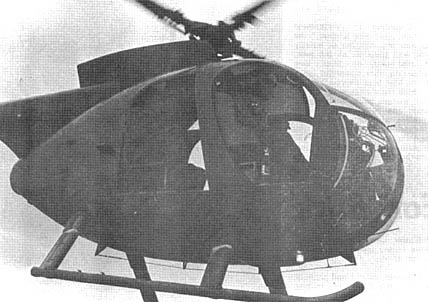 |
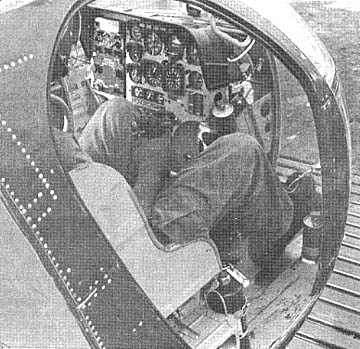 |
DIALS AND GUAGES -- A myriad of instruments faces a Light Observation Helicopter pilot at the 3rd Brigade Aviation Pad at Cu Chi. |
Page 8 TROPIC LIGHTNING NEWS August 31, 1970
Louisiana VIP Drops In
Governor Visits FSB Snider
By SP4 JAMES DURAN
FSB SNIDER - The radios crackled: "All guns, all guns. Have your men in
uniform. VIP enroute."
In a short time, the sound of choppers increasing in volume and finally with
the ever present cloud of dust, Governor John J. McKeithan of Louisiana,
accompanied by Assistant 25th Division Commander Brigadier General Michael J. L.
Green, arrived at Fire Support Base Snider.
Located four miles northeast of Cu Chi, this fire base is the new home of the
3rd Battalion, 13th Field Artillery's Bravo Battery.
"I was in Japan on business and I thought I was close enough to extend my
travels to Vietnam," the governor said. "I'm making this a combined goodwill
and personal fact-finding tour.
"It is a fine honor to be able to extend to you men the gratitude and
admiration that we back home have for you all," the governor said to the men of
Bravo Battery. "I know that through your letters and the news media you hear a
great many bad things.
"Unfortunately, it is the bad news that makes the majority of the headlines.
But I want to impress upon you the great numbers of Americans who are cheering
for you and praying for your safe return."
When asked if he was finding the situation in Vietnam as he expected it,
McKeithan, who is a former combat engineer, said that it was much like he
thought it would be.
"Wherever Americans go, they always work hard to make life as good for
themselves as they can. I know that this base camp has not been in existence
long.
However, one need only take a quick glance around to see all of the hard work
and tremendous effort that has been so characteristic of you men over here."
Governor McKeithan toured the fire base, stopping at each section to talk to
the Clansmen informally. At one point he even entered one of the bunkers to
inspect the living quarters.
For men whose home is in Louisiana, he had an additional surprise.
"Now make sure and write your address and phone number down and when I get
home, I'm going to call your mothers and fathers and tell them I talked to you."
After a tour of the mess facilities and a short pause for a cold drinks, the
visitors reboarded the chopper to visit another location.
| HIGH RIDING WARRIOR - One of the men of the 2nd of the 12th sits atop Warrior totem pole erected at Dau Tieng some years ago. |
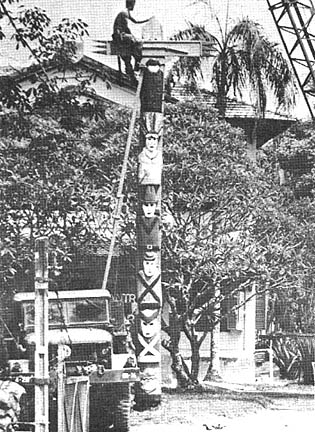 |
25th Med Heals Sick
Main Gate Clinic is Busy
BY SGT DERR STEADMAN
Every weekday at 11 a.m., a medic from the 25th Infantry Division's 25th
Medical Battalion receives patients for sick call at the main gate of Cu Chi
Base Camp.
Specialist 4 Larry E. Kramer, of Arkansas City, Kan., a medic trained at Fort
Riley, Kan., to be an operating room technician, has been working at the main
gate for almost two months.
"I usually work at the gate every day and enjoy doing as much as I can for
the patients - mostly small children and elderly people from the villages and
hamlets near Cu Chi, says Kramer.
When the medic, accompanied by a female Vietnamese interpreter, arrives at
the small shed near the gate, he finds the patients already standing in line
waiting to be treated. Before the sick call is completed, usually by 1 p.m., an
average of 50 persons will have been examined and treated.
"According to Vietnamese custom", explains Kramer, "the women and children
sit quietly and wait until all of the men, usually suffering from skin
irritations, infections and body aches, have been treated."
Once the men have been seen, the women with body sores, colds and other
ailments; and children with cuts, bruises and occasional fractures, gather
around the interpreter explaining their problems. Then, one by one, they are
examined by the medic.
"The most disturbing part of my work," says Kramer, "is that many of the
patients suffer unnecessarily because they simply do not know how to take care
of themselves."
"Most of the people," he adds "will wait, not realizing the potential
severity of their ailments, until their illnesses have reached the more advanced
stages before they will seek medical treatment."
Likewise, most injuries are not treated until they have become infected, thus
decreasing the chances for proper healing and extending the period of needless
discomfort.
"Most of the patients treated at the main gate are given whatever medicines
they need and are dismissed with instructions to return after a few days for
further examination." Kramer said.
Those persons requiring a doctor's examination - the more serious cases - are
taken by ambulance to the Arthur E. Lewis Dispensary at the 25th Med. At the
dispensary, minor surgery is performed and shots are given to those patients who
require these and other such involved treatments.
"These persons," according to Kramer, "are usually released and returned to
the main gate by mid afternoon."
The still more serious cases, however, are admitted to the Vietnamese Ward at
the 25th Med, where they may remain for whatever time is required to bring their
afflictions under control.
| A FRIEND TO THE SICK - Specialist 4 Larry E. Kramer, of Arkansas City, Kan., a medic with the 25th Division's 25th" Medical Battalion, prepares medications for one of his smaller patients. (Photo by SGT Derr Steadman) |
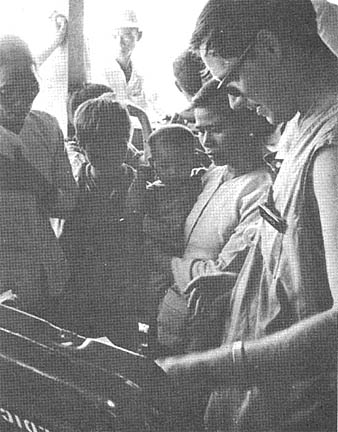 |
Ridges Are Familiar;
Warriors Come Home
By SP4 ED TOULOUSE
DAU TIENG - Working the razor back ridges of this area is not a novel
experience for the 25th Division's 2nd Battalion, 12th Infantry. They've been
here before.
Battalion influence in Dau Tieng dates back to late 1966 when, as a 4th
Division unit, the Warriors were spearheading pacification efforts in the region
which was, at that time, a VC stronghold.
The following newspaper headlines appearing in the spring of 1967 are tribute
to Warrior efforts:
"2/12 Troopers Find 200 Ton Rice Cache"
"White Warriors find VC Complex"
"12th Infantry Kills 95"
"Dau Tieng Attacked--Enemy Repelled"
"2/12 Kills 18 Near Base Camp"
"Warriors Discover Enemy 'Underground' Newspaper"
Lead paragraphs from stories done at the time reveal how the men of the 2nd
of the 12th left their imprint on Dau Tieng. An official describes civic action
contributions:
"DAU TIENG - At first, the kids didn't even smile at us, but after more and
more MEDCAPs medical civic action programs, they came around.
"DAU TIENG - The 2nd Battalion, 12th Infantry, getting a chance to show its
versatility, recently moved in and cleaned up a French pool which had been
marred by twenty years of neglect and war."
"DAU TIENG - A forty foot totem pole depicting major conflicts in the 2nd
Battalion, 12th Infantry's history was recently unveiled in a brief ceremony."
"DAU TIENG - Enlisted men of the 2nd Battalion, 12th Infantry have a
brand-new club of their own. It required some $1,000 and only six days of
work."
The Warriors are back at Dau Tieng now after two years at points north,
south, east and west, ready to make more marks on the face of the base camp and
surrounding countryside.
Incoming! Incoming!
Bodies Tense, Ears Prick
By SP4 ED TOULOUSE
DAU TIENG -- A thunder-like blast cuts through the nighttime silence of this
base camp. Bodies tense. Ears prick. Suddenly, the air is filled with the
shattering splash of a million deadly fragments.
"Incoming!" The cry barely precedes the frenzied wail of the siren alert.
From all corners of the base camp, adrenalin propelled GIs run, scramble, and
dive into the relative security of strategically placed bunkers.
At no other time can the value of such everyday items such as sandbags,
p.s.p. and sandboxes be more thoroughly appreciated. The hours of sweat and
frustration that go into the construction of these bunkers pay dividends during the rocket and mortar
attacks that have been plaguing this base camp for the past several months.
Such attacks have paralyzing effects. With the detonation of the first
round, most of the base personnel must take the defensive. Quite possibly,
several more enemy rounds are already in the air.
However, mortar and artillery teams waste little time trading retaliatory
punches with Charlie. The business end of an artillery piece frequently puts at
least a temporary end to the incoming.
In the aftermath, taut-nerved GIs emerge from their cover and return to their
hootches possibly asking themselves "when again?"
Thanks to:
Roger Welt, 4th Bn., 23rd Inf., and a Tropic Lightning News correspondent,
for sharing this issue,
Kirk Ramsey, 2nd Bn., 14th Inf. for creating this page.
This page last modified 08-06-2006
©2006 25th Infantry Division Association. All rights reserved